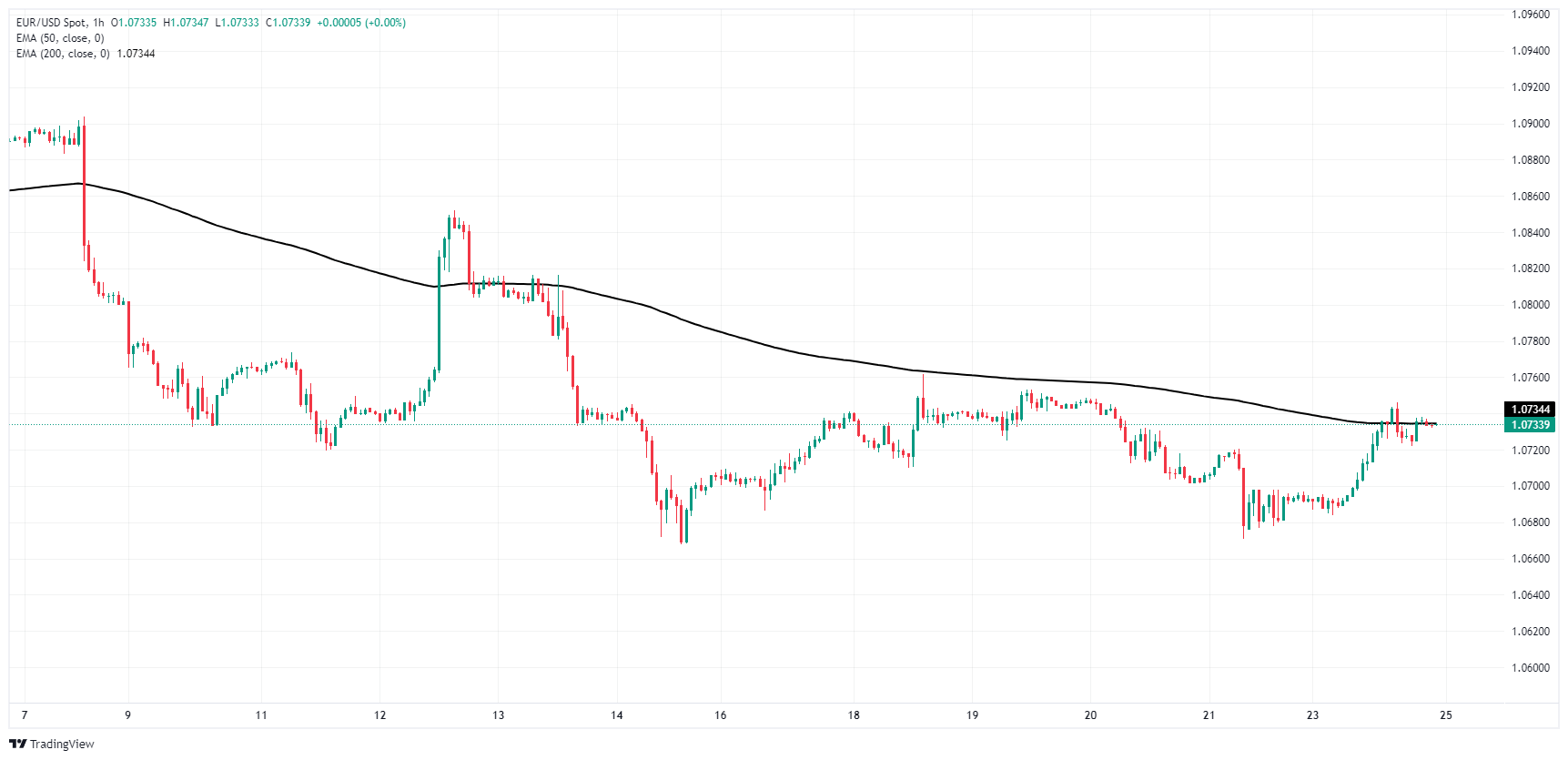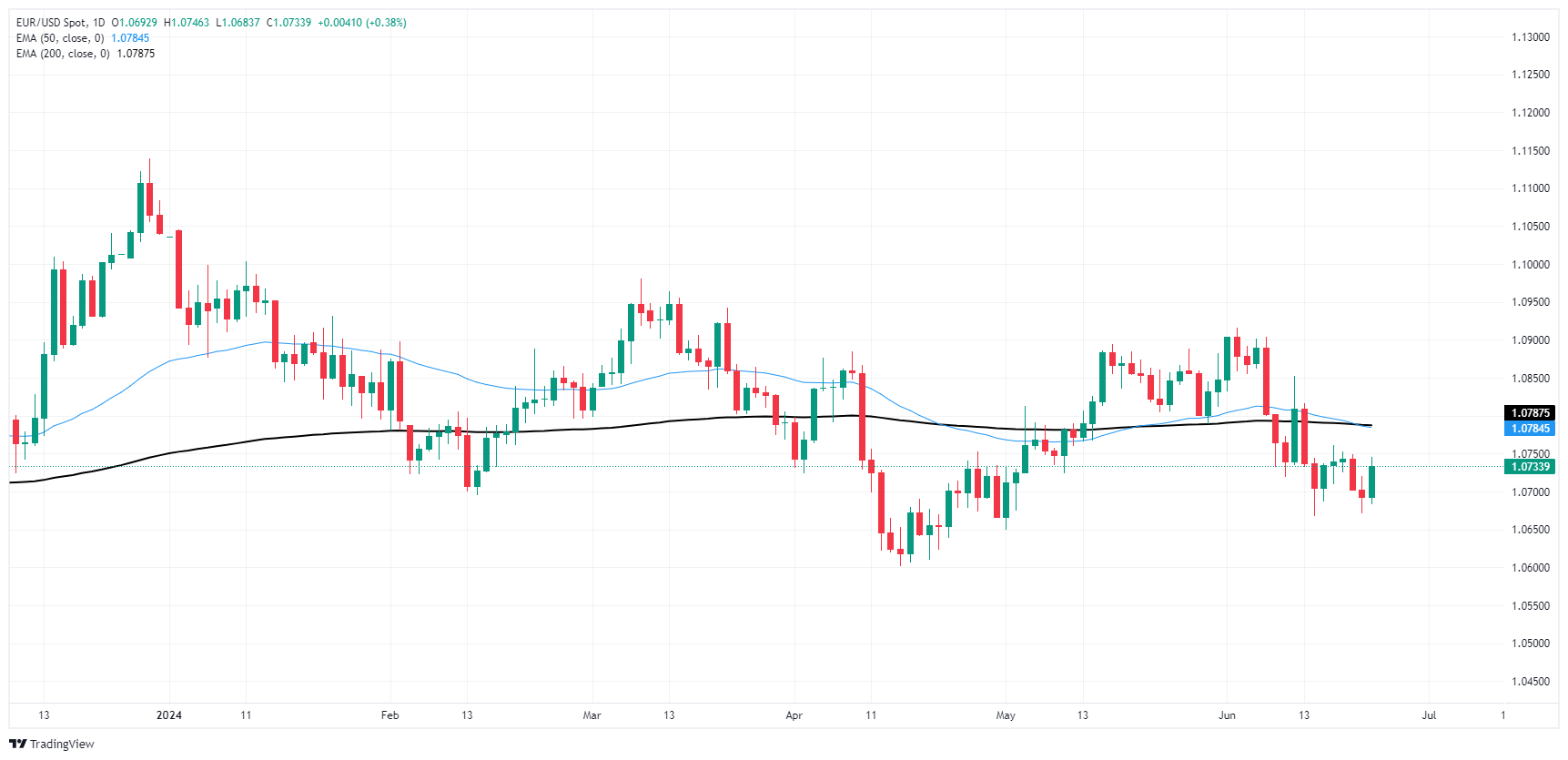- Phân tích
- Tin tức và các công cụ
- Tin tức thị trường
- EUR/USD catches a ride on broad-market Greenback weakness
EUR/USD catches a ride on broad-market Greenback weakness
- EUR/USD recovered from last week’s downside but remains hung up on 1.0730.
- As USD flows turned lower, Euro traders shrugged off a miss in German data.
- Tuesday restricted to mid-tier releases, and a fistful of central planner speeches.
EUR/USD drifted up in a mild recovery from last Friday’s dip into 1.0670. The new trading week is kicking things off with risk appetite firmly pinned higher, sending the US Dollar lower and bolstering the Euro as investors head into a relatively quiet Tuesday.
Fed's Daly: Inflation is not the only risk, but recent inflation readings are more encouraging
Key economic data releases are relegated to later in the week, leaving traders to focus on statements from policymakers that dot the landscape until meaningful data releases kick off in the back half of the trading week. An update to US Gross Domestic Product (GDP) figures is slated for Thursday, with Friday rounding out the trading week with German Retail Sales and the latest update for US Personal Consumption Expenditure (PCE) Price Index inflation.
Fed's Goolsbee: Slowing inflation data would open door to easier policy
Tuesday’s economic calendar is notably restrained, with an appearance expected from German central bank President Joachim Nagel. During Tuesday's US market session, Federal Reserve (Fed) officials are expected to give several speeches, and central planners will likely lean into middling Fedspeak in echoes of Monday’s performances.
German sentiment surveys broadly missed expectations early Monday, but Euro markets are flaunting downside EU figures to follow the broader market higher as risk appetite continues to pin to hopes of at least a quarter-point cut from the Federal Open Market Committee’s (FOMC) September 18 rate call. According to the CME’s FedWatch Tool, rate traders are pricing in around 70% odds of a 25 basis point rate trim from the Fed in September.
EUR/USD technical outlook
EUR/USD pulled higher after walking back last Friday’s dip into 1.0670, but bullish momentum hit a snag after intraday bids got hung up on the 200-hour Exponential Moving Average (EMA) at 1.0737. EUR/USD still remains on the low side on daily candles, with price action trading on the bearish side of the 200-day EMA at 1.0815.
EUR/USD hourly chart
EUR/USD daily chart
Euro FAQs
The Euro is the currency for the 20 European Union countries that belong to the Eurozone. It is the second most heavily traded currency in the world behind the US Dollar. In 2022, it accounted for 31% of all foreign exchange transactions, with an average daily turnover of over $2.2 trillion a day. EUR/USD is the most heavily traded currency pair in the world, accounting for an estimated 30% off all transactions, followed by EUR/JPY (4%), EUR/GBP (3%) and EUR/AUD (2%).
The European Central Bank (ECB) in Frankfurt, Germany, is the reserve bank for the Eurozone. The ECB sets interest rates and manages monetary policy. The ECB’s primary mandate is to maintain price stability, which means either controlling inflation or stimulating growth. Its primary tool is the raising or lowering of interest rates. Relatively high interest rates – or the expectation of higher rates – will usually benefit the Euro and vice versa. The ECB Governing Council makes monetary policy decisions at meetings held eight times a year. Decisions are made by heads of the Eurozone national banks and six permanent members, including the President of the ECB, Christine Lagarde.
Eurozone inflation data, measured by the Harmonized Index of Consumer Prices (HICP), is an important econometric for the Euro. If inflation rises more than expected, especially if above the ECB’s 2% target, it obliges the ECB to raise interest rates to bring it back under control. Relatively high interest rates compared to its counterparts will usually benefit the Euro, as it makes the region more attractive as a place for global investors to park their money.
Data releases gauge the health of the economy and can impact on the Euro. Indicators such as GDP, Manufacturing and Services PMIs, employment, and consumer sentiment surveys can all influence the direction of the single currency. A strong economy is good for the Euro. Not only does it attract more foreign investment but it may encourage the ECB to put up interest rates, which will directly strengthen the Euro. Otherwise, if economic data is weak, the Euro is likely to fall. Economic data for the four largest economies in the euro area (Germany, France, Italy and Spain) are especially significant, as they account for 75% of the Eurozone’s economy.
Another significant data release for the Euro is the Trade Balance. This indicator measures the difference between what a country earns from its exports and what it spends on imports over a given period. If a country produces highly sought after exports then its currency will gain in value purely from the extra demand created from foreign buyers seeking to purchase these goods. Therefore, a positive net Trade Balance strengthens a currency and vice versa for a negative balance.
© 2000-2024. Bản quyền Teletrade.
Trang web này được quản lý bởi Teletrade D.J. LLC 2351 LLC 2022 (Euro House, Richmond Hill Road, Kingstown, VC0100, St. Vincent and the Grenadines).
Thông tin trên trang web không phải là cơ sở để đưa ra quyết định đầu tư và chỉ được cung cấp cho mục đích làm quen.
Giao dịch trên thị trường tài chính (đặc biệt là giao dịch sử dụng các công cụ biên) mở ra những cơ hội lớn và tạo điều kiện cho các nhà đầu tư sẵn sàng mạo hiểm để thu lợi nhuận, tuy nhiên nó mang trong mình nguy cơ rủi ro khá cao. Chính vì vậy trước khi tiến hành giao dịch cần phải xem xét mọi mặt vấn đề chấp nhận tiến hành giao dịch cụ thể xét theo quan điểm của nguồn lực tài chính sẵn có và mức độ am hiểu thị trường tài chính.
Sử dụng thông tin: sử dụng toàn bộ hay riêng biệt các dữ liệu trên trang web của công ty TeleTrade như một nguồn cung cấp thông tin nhất định. Việc sử dụng tư liệu từ trang web cần kèm theo liên kết đến trang teletrade.vn. Việc tự động thu thập số liệu cũng như thông tin từ trang web TeleTrade đều không được phép.
Xin vui lòng liên hệ với pr@teletrade.global nếu có câu hỏi.















